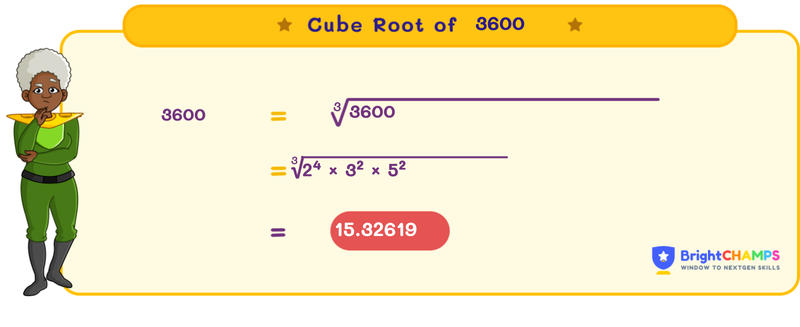Summarize this article:
 288 Learners
288 LearnersLast updated on August 5, 2025
Cube Root of 3600

A number we multiply by itself three times to get the original number is its cube root. It is used in various real-life applications, such as determining the dimensions of cube-shaped objects and in architecture. We will now find the cube root of 3600 and explore the methods used to calculate it.

What is the Cube Root of 3600?
We have learned the definition of the cube root. Now, let’s learn how it is represented using a symbol and exponent. The symbol we use to express the cube root is the radical sign (∛), and the exponent we use is ⅓.
In exponential form, ∛3600 is written as 3600(1/3). The cube root is just the opposite operation of finding the cube of a number. Since the cube root of 3600 is not an exact value, we can write it as approximately 15.273.


Finding the Cube Root of 3600
Finding the cube root of a number involves identifying the number that must be multiplied three times to result in the target number. Now, we will go through the different ways to find the cube root of 3600. The common methods we follow to find the cube root are given below:
- Prime factorization method
- Approximation method
- Subtraction method
- Halley’s method
To find the cube root of a non-perfect cube number, we often use Halley’s method. Since 3600 is not a perfect cube, we use Halley’s method.

Cube Root of 3600 by Halley’s method
Let's find the cube root of 3600 using Halley’s method.
The formula is: ∛a ≅ x((x³ + 2a) / (2x³ + a))
where: a = the number for which the cube root is being calculated
x = the nearest perfect cube
Substituting, a = 3600;
x = 15
∛a ≅ 15((15³ + 2 × 3600) / (2 × 15³ + 3600))
∛3600 ≅ 15((3375 + 7200) / (6750 + 3600))
∛3600 ≅ 15.273
The cube root of 3600 is approximately 15.273.
Explore Our Programs



Common Mistakes and How to Avoid Them in the Cube Root of 3600
Finding the cube root of a number without any errors can be challenging for students. This occurs for various reasons. Here are a few common mistakes students make and ways to avoid them:

Cube Root of 3600 Examples:

Problem 1
Imagine you have a cube-shaped container that has a total volume of 3600 cubic centimeters. Find the length of one side of the container.

Side of the container = ∛3600 ≈ 15.273 units
Explanation
To find the side of the container, we need to find the cube root of the given volume.
Therefore, the side length of the container is approximately 15.273 units.

Problem 2
A company manufactures 3600 cubic meters of material. Calculate the amount of material left after using 1200 cubic meters.

The amount of material left is 2400 cubic meters.
Explanation
To find the remaining material, subtract the used material from the total amount:
3600 - 1200 = 2400 cubic meters.

Problem 3
A storage tank holds 3600 cubic meters of water. Another tank holds a volume of 800 cubic meters. What would be the total volume if the tanks are combined?

The total volume of the combined tanks is 4400 cubic meters.
Explanation
Add the volume of both tanks:
3600 + 800 = 4400 cubic meters.

Problem 4
When the cube root of 3600 is multiplied by 2, calculate the resultant value. How will this affect the cube of the new value?

2 × 15.273 = 30.546 The cube of 30.546 ≈ 28,559.54
Explanation
When we multiply the cube root of 3600 by 2, it results in a significant increase in the volume because the cube increases exponentially.

Problem 5
Find ∛(4600 + 4600).

∛(4600 + 4600) = ∛9200 ≈ 20.95
Explanation
As shown in the question ∛(4600 + 4600), simplify by adding them: 4600 + 4600 = 9200.
Then compute: ∛9200 ≈ 20.95 to get the answer.


FAQs on 3600 Cube Root
1.Can we find the Cube Root of 3600?
2.Why is the Cube Root of 3600 irrational?
3.Is it possible to get the cube root of 3600 as an exact number?
4.Can we find the cube root of any number using prime factorization?
5.Is there any formula to find the cube root of a number?

Important Glossaries for Cube Root of 3600
- Cube root: The number that is multiplied three times by itself to get the given number is the cube root of that number.
- Perfect cube: A number is a perfect cube when it is the product of multiplying a number three times by itself. A perfect cube always results in a whole number. For example: 2 × 2 × 2 = 8, therefore, 8 is a perfect cube.
- Exponent: The exponent form of a number denotes the number of times a number can be multiplied by itself. In 3600(1/3), ⅓ is the exponent which denotes the cube root of 3600.
- Radical sign: The symbol that is used to represent a root, expressed as (∛).
- Irrational number: Numbers that cannot be put in fractional forms are irrational. For example, the cube root of 3600 is irrational because its decimal form continues infinitely without repeating.



Jaskaran Singh Saluja
About the Author
Jaskaran Singh Saluja is a math wizard with nearly three years of experience as a math teacher. His expertise is in algebra, so he can make algebra classes interesting by turning tricky equations into simple puzzles.
Fun Fact
: He loves to play the quiz with kids through algebra to make kids love it.

















